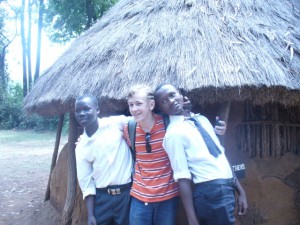I have been talking about trying to get a guest blog from either my sister, Lauryn, or my 14 year old nephew, Nate, about their mission trip to Africa in August. My nephew finally sent me his story. It’s rather lengthy, so I’m going to do it as a series for a few days. The following is Nate’s story, in his own words:
August 5th of this year was like any other day all over thePortland area. People still got up, got dressed, ate early breakfasts, headed off to work, doing what anyone else would normally do. But I and my mom were in our car bright and early, headed for the airport. My mother and I were part of a team that was undertaking a mission trip literally half a world away from the familiar sights and sounds of Oregon, to a country known as Kenya.
Kenya, as many people know, is a country on the eastern coast of the African continent, next to Lake Victoria and the beginning of the Nile River. Though being one of the largest and most powerful countries in Africa (the capital, Nairobi, is alone one of Earth’s most populated cities), most of the country is comprised of either large, underdeveloped slums or vast, fertile farmland, both about as undeveloped as we, with our sophisticated western lives, can possibly imagine. And though Kenya is a large trading hub, and has a national income to match, on the individual level,Kenya’s people are, for the most part, not nearly as wealthy as those in the more developed western nations. To make things worse, due to 2012 being an election year (which, through some odd coincidence, is also our election year), the eastern part of Kenya, right on the coast, and close to Somalia (where most of the modern pirates come from) is experiencing a large rebellion by people who are all trying to put their favorite presidential candidates in office. The government system is not much better. There is a lot of corruption inside it, which comes into everyday Kenya as well. And because the government, oddly, has the same financial problems as everyone else, they can’t fund better housing projects, street repairs, or even a waste collection system.
I arrived in Kenya in the middle of all this corruption, instability, unrest, and poverty on August 6th, after a brief stop in Amsterdam. From the Nairobi airport, we were bussed off to the place we were staying, at a guest house run by the Free Pentecostal Fellowship of Kenya (FPFK). Every morning we would be served an excellent breakfast, and a good dinner in the evening. Our first full day (Tuesday) was spent packing pills for the medical team (our whole “Kenya Team” was made up of a medical team and an educational team) and taking the students of a Kenyan high school that we would be working at to a culture center on the outskirts of Nairobi. The next two days (Wednesday-Thursday) were spent at the high school from which the students came: New Dawn High School. As part of the educational team, I was helping to teach an art class headed by another team member. Though the school itself was a fairly new and excellent building, it sat in the Huruma slum, a suburb of Nairobi that was made of tin-sheet houses, narrow dirt alleyways, and deep sewage ditches that the small children who played outside the school often tripped over. It was a powerful and dramatic example of the stark poverty that defines Kenya at the individual level. The kids at the school ranged in age from 14 or 15 years old in the youngest freshmen to an astonishing 23 years old with many of the seniors. I met many wonderful people and great friends among these high schoolers.

